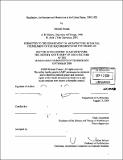Regulation, architecture and modernism in the United States, 1890-1920
Author(s)
Osman, Michael
DownloadFull printable version (68.76Mb)
Other Contributors
Massachusetts Institute of Technology. Dept. of Architecture.
Advisor
Mark Jarzombek.
Terms of use
Metadata
Show full item recordAbstract
This dissertation examines the modernization of the United States through a group of regulatory techniques and institutions that emerged in the early twentieth century. In this period, conceptions of power based on laissez-faire capitalism were giving way to systems of governance that aimed to control the economies of the home, market, nature and labor. Methods of avoiding, delaying, and constraining the uncertainties resulting from the massive economic development of the nation established a new approach to securing its future through the regulation of risk. While predictability and efficiency are often invoked as core principles of modernism, these were in fact ideologies that gained their force through these earlier attempts to manage and forestall risk. The dissertation identifies four cases in which technology and architecture served as critical instruments for the implementation of regulation in the modern interior. The application of thermostatic control of heat for domestic architecture established a norm for room temperature that, through the home economics movement, became a hygienic standard for the modern American home. In cold storage facilities, mechanical refrigeration technologies were employed to regulate the longevity of perishable food. By extending the life of produce, these warehouses served as control centers for distributing the nation's food supply and regulating the futures market that determined their prices. (cont.) Even more dramatic manipulations of the environment were enacted in ecological laboratories. Packed with control systems, these structures played a crucial role in the development of research that explored the governing dynamics of the economy of nature; they sought to connect the life of organisms to fluctuations in their surrounding environment. In factories, plant owners hired engineers to install production control systems to regulate the relations between machines, men and the market. The techniques devised by these mangers sought to make industry both responsive and resistant to unstable and often unpredictable fluctuations in demand.
Description
Thesis (Ph. D.)--Massachusetts Institute of Technology, Dept. of Architecture, 2008. Includes bibliographical references (p. 239-256).
Date issued
2008Department
Massachusetts Institute of Technology. Department of ArchitecturePublisher
Massachusetts Institute of Technology
Keywords
Architecture.